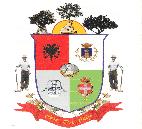Primo Delcalzo
Chieuti-Albanian Connection
When they didn’t want the kids to understand what they were saying, my mother and her relatives spoke in their language. However, that language wasn’t Italian; it was Albanian (or Arbëresh), the dialect of Chieuti. Primo DelCalzo’s father was born in Chieuti and his mother was born in Serracapriola. Here is Primo’s article about the Chieuti-Albanian connection.
The DelCalzo Family’s Albanian Heritage
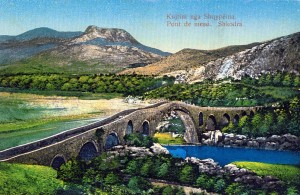 Albania is a mountainous country rising above the eastern coastline of the Adriatic Sea which is part of the Mediterranean Ocean. Some one thousand years before the birth of Christ our ancient ancestors of the iron age of man’s development moved south into these mountains from what is now Bavaria and Slovenia. These fair skinned and blue eyed people were called Illyrians and survived as shepherds in the lofty hills overlooking the sea. They lived in small family tribes or clans ruled by family leaders or elders. Those that lived down by the shore lived by fishing and by piracy, attacking and plundering the trading ships from Venice that moved up and down the coast. The shepherds lived up in the hills and mountains and were known as the free peasants of the highlands. Some historians and poets have compared these independent highlanders with the highlanders of Scotland and Ireland and like them the men folk wore heavy wool kilts. Each family had its grazing pastures for their sheep, goats, horses and other animals and for a thousand years this way of life became ingrained into their mind, body, and spirit, and for some still remains strong today. The men needed to be good hunters to protect themselves, their families and their sheep from packs of ferocious wolves that roamed the mountains. There were also the wild boars and bears to contend with. Fortunately there were plenty of wild goats which provided food for the families. The men liked to take their flutes and small stringed guitars with them while guarding their sheep. Because they shared their high perches in the hills with the soaring eagles they called their country the “Land of the Eagle” (Shqiperia) and referred to themselves as “Sons of the Eagle” (Shqipetare).
Albania is a mountainous country rising above the eastern coastline of the Adriatic Sea which is part of the Mediterranean Ocean. Some one thousand years before the birth of Christ our ancient ancestors of the iron age of man’s development moved south into these mountains from what is now Bavaria and Slovenia. These fair skinned and blue eyed people were called Illyrians and survived as shepherds in the lofty hills overlooking the sea. They lived in small family tribes or clans ruled by family leaders or elders. Those that lived down by the shore lived by fishing and by piracy, attacking and plundering the trading ships from Venice that moved up and down the coast. The shepherds lived up in the hills and mountains and were known as the free peasants of the highlands. Some historians and poets have compared these independent highlanders with the highlanders of Scotland and Ireland and like them the men folk wore heavy wool kilts. Each family had its grazing pastures for their sheep, goats, horses and other animals and for a thousand years this way of life became ingrained into their mind, body, and spirit, and for some still remains strong today. The men needed to be good hunters to protect themselves, their families and their sheep from packs of ferocious wolves that roamed the mountains. There were also the wild boars and bears to contend with. Fortunately there were plenty of wild goats which provided food for the families. The men liked to take their flutes and small stringed guitars with them while guarding their sheep. Because they shared their high perches in the hills with the soaring eagles they called their country the “Land of the Eagle” (Shqiperia) and referred to themselves as “Sons of the Eagle” (Shqipetare).
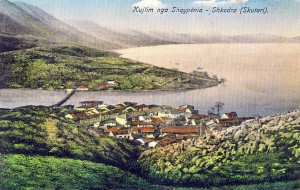 An early threat to the freedom of the Shqipetare was the Roman Empire which wanted their land for the vast highway connecting Europe with the with the East known as the Via Ignatia. Julius Caesar was so impressed by the resistance and fighting skill of the Shqipetare that he offered them positions in his army. Some of our Albanian ancestors would later go on to become Roman emperors including the emperor Constantine the Great who converted to Christianity and called the first Christian Council at Nicaea which resulted in the Nicene Creed which is followed by most Christians today. Many of the sons of the eagle returned again to their beloved hills but would never again enjoy the peace they had in the past. The Roman conquerors were followed by the Barbarians who swept down from the northeast and west murdering and pillaging and again they took up arms to fight the invaders. Then one thousand years after the birth of Christ the crusaders crossed their country on the way to the Holy Land to fight the Moslems whose God was Allah and whose prophet was Mohammad. The crusaders were joined by our Shqipetare ancestors who built fires to forge steel to make their long swords and helmets and their shining shields with the emblem of the double headed eagle. They mounted their small swift horses and set off as Christian knights hoping to recapture the birthplace of Christ from the armies of Islam. By now Albania, like most of Europe in the Middle Ages was a feudal society. There were family or clan leaders who became princes or nobleman, who had used the military skills of the Shqipetare to set themselves up as overlords controlling many families. Around the castles of the nobles villages and towns developed where traders, merchants, and artisans were learning a new style of living. However, the hills still belonged to the sons of the eagle where family loyalty and tribal traditions still ruled. The family tribes of our ancestors were led by the oldest male member, who was additionally advised by a council of elders. The members of the family shared common pasture lands and followed ancient unwritten customs which came to be known of as the Law of Lek. This law guided all aspects of legal and social behavior including property rights, betrothal, marriage, and moral standards.
An early threat to the freedom of the Shqipetare was the Roman Empire which wanted their land for the vast highway connecting Europe with the with the East known as the Via Ignatia. Julius Caesar was so impressed by the resistance and fighting skill of the Shqipetare that he offered them positions in his army. Some of our Albanian ancestors would later go on to become Roman emperors including the emperor Constantine the Great who converted to Christianity and called the first Christian Council at Nicaea which resulted in the Nicene Creed which is followed by most Christians today. Many of the sons of the eagle returned again to their beloved hills but would never again enjoy the peace they had in the past. The Roman conquerors were followed by the Barbarians who swept down from the northeast and west murdering and pillaging and again they took up arms to fight the invaders. Then one thousand years after the birth of Christ the crusaders crossed their country on the way to the Holy Land to fight the Moslems whose God was Allah and whose prophet was Mohammad. The crusaders were joined by our Shqipetare ancestors who built fires to forge steel to make their long swords and helmets and their shining shields with the emblem of the double headed eagle. They mounted their small swift horses and set off as Christian knights hoping to recapture the birthplace of Christ from the armies of Islam. By now Albania, like most of Europe in the Middle Ages was a feudal society. There were family or clan leaders who became princes or nobleman, who had used the military skills of the Shqipetare to set themselves up as overlords controlling many families. Around the castles of the nobles villages and towns developed where traders, merchants, and artisans were learning a new style of living. However, the hills still belonged to the sons of the eagle where family loyalty and tribal traditions still ruled. The family tribes of our ancestors were led by the oldest male member, who was additionally advised by a council of elders. The members of the family shared common pasture lands and followed ancient unwritten customs which came to be known of as the Law of Lek. This law guided all aspects of legal and social behavior including property rights, betrothal, marriage, and moral standards.
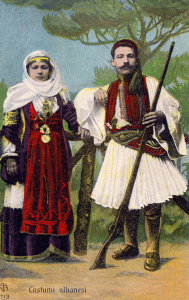 In the 15th Century, about 500 years ago following the dark and middle ages the Western and Eastern Christian empire known as The Holy Roman Empire and the Byzantine Empire no longer had powerful armies. However at this time the Muslim religion was rapidly gaining power and conquering lands in its march north under the name of the Ottoman Empire led by Turkish Sultans. The Turkish armies, often numbering in the hundreds of thousands, advanced toward Albania threatening its southern border. At the same time a powerful Venetian army from northern Italy was coming down to capture and hold Albania for its own. The freedom of our ancestors was threatened once again. A notable tribal leader by the name of John Castriota, whose family crest bore an emblem of an eagle, gathered together the rulers of other clans and through the marriages of his five daughters and four sons gained control over a large area of the northern mountains. John Castriota tried to use his power and influence to keep the two conquering armies from taking over his mountains. He finally had to acknowledge the Turkish Sultan or king as his overlord and he signed a friendship treaty with the Venetians. For a while this worked, but the Turkish demands kept growing and he had to give up more and more Albanian land. As a final concession he agreed to change his religion from Christianity to Islam, to change his name from an Albanian one to a Turkish one, and to become an Ottoman feudal lord even though he had little use for the Turks. He was also required to pay a yearly tribute to the Turkish Sultan and to insure that he would remain loyal to the sultan his son George was taken to Turkey as a child hostage as was the custom of the conquerors. His attempts to hold his country from foreign domination failed. The Albanians who lost their land seethed in anger and the ruling families from the northern coastal area of Shkodra or Scuteri, where many of our ancestors came from, rose up in 1433 and with their horse mounted cavalry units annihilated a Turkish army in one of the mountain passes and became famous throughout Europe.
In the 15th Century, about 500 years ago following the dark and middle ages the Western and Eastern Christian empire known as The Holy Roman Empire and the Byzantine Empire no longer had powerful armies. However at this time the Muslim religion was rapidly gaining power and conquering lands in its march north under the name of the Ottoman Empire led by Turkish Sultans. The Turkish armies, often numbering in the hundreds of thousands, advanced toward Albania threatening its southern border. At the same time a powerful Venetian army from northern Italy was coming down to capture and hold Albania for its own. The freedom of our ancestors was threatened once again. A notable tribal leader by the name of John Castriota, whose family crest bore an emblem of an eagle, gathered together the rulers of other clans and through the marriages of his five daughters and four sons gained control over a large area of the northern mountains. John Castriota tried to use his power and influence to keep the two conquering armies from taking over his mountains. He finally had to acknowledge the Turkish Sultan or king as his overlord and he signed a friendship treaty with the Venetians. For a while this worked, but the Turkish demands kept growing and he had to give up more and more Albanian land. As a final concession he agreed to change his religion from Christianity to Islam, to change his name from an Albanian one to a Turkish one, and to become an Ottoman feudal lord even though he had little use for the Turks. He was also required to pay a yearly tribute to the Turkish Sultan and to insure that he would remain loyal to the sultan his son George was taken to Turkey as a child hostage as was the custom of the conquerors. His attempts to hold his country from foreign domination failed. The Albanians who lost their land seethed in anger and the ruling families from the northern coastal area of Shkodra or Scuteri, where many of our ancestors came from, rose up in 1433 and with their horse mounted cavalry units annihilated a Turkish army in one of the mountain passes and became famous throughout Europe.
The skill of these sword swinging horse soldiers is still remembered in Europe today. It is interesting to note that Giovanni “John” Scudieri who married Maria Grazia Del Calzo in the Albanian village of Chieuti Italy in 1892 was himself a cavalry soldier. John, who was beloved by all of us that knew him, was known for his remarkable horsemanship when he served in the Italian cavalry many centuries after that famous battle in Albania. John said that his family name of Scudieri, was taken from their village of Scuteri in Albania, which the Shqipetare fought to keep from the Turks over five hundred years ago. A street in the village of Chieuti bears the Scudieri family name.
Following that ancient battle three more Turkish armies were defeated by the swift riding horseman of the Albanian tribes. The Shqipetare used little armor and could move very fast on their small swift horses while the 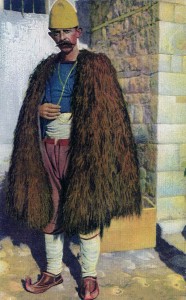 enemy knights and soldiers often fought with heavy suits of armor to protect themselves. The Shqipetare light cavalry charged in cutting the Turks to pieces and then disappeared back into the mountains where they hid till the next attack. Though their fame in battle grew into the legends of that time they were finally overpowered by massive Turkish forces which advanced deeper and deeper into the Christian areas of Serbia, Transylvania, Hungary and Poland and the war raged on for years.
enemy knights and soldiers often fought with heavy suits of armor to protect themselves. The Shqipetare light cavalry charged in cutting the Turks to pieces and then disappeared back into the mountains where they hid till the next attack. Though their fame in battle grew into the legends of that time they were finally overpowered by massive Turkish forces which advanced deeper and deeper into the Christian areas of Serbia, Transylvania, Hungary and Poland and the war raged on for years.
John Castriota’s son George who was taken hostage by the Turks was to become the King Arthur of Eastern Europe, a real, not an imaginary knight. George was born around 1405 and as a young boy was forced to attend a Turkish military school and to convert to Islam. This meant that he had to be given a new name, a Turkish name under which he would have to fight as a Turkish soldier. Because he was so smart and brave, the Turks named him Iskander which was their name for Alexander the Great who was Greek general who conquered a large part of the world 300 years before the birth of Christ. Young George was also given the title of Beg which was Turkish for general. Iskender Beg in Albanian is pronounced Skanderbeg and it is with this name that he was to become one of the most famous knights of the 15th century. After training him to be one of their generals the Turks promised that he could go back to Albania as governor when his father died, but they betrayed him. At the same time the Albanians were secretly asking him to lead them in a revolt against the Turks. Also at this time a Hungarian Knight named Janosh Hunyadi was attacking the Turks in Transylvania. Skanderbeg recruited 300 horsemen and headed for his family’s village and in the dead of night killed the Turkish soldiers and raised his red flag with the black double headed eagle and the long cruel and bloody war to drive the Turks out of Europe began.
 In the story of history Skanderbeg is remembered as the good and noble knight who tried to free and protect his people by uniting them as allies in a common cause. At the same time there was another knight in the north, in a country called Transylvania, who was also to become famous as a black or bad knight. He too had been held hostage as a boy by the Turks and trained in politics and diplomacy and was returned to his home to function as a Turkish prince. This prince, by the name of Vlad Dracula, also decided to drive the Turks from his mountains. However, as a warrior knight he became so suspicious and angry that soon he was fighting everyone including his friends who he thought were going to betray or kill him.. Skanderbeg fought under the flag or the sign of the eagle and always tried to bring his people and friends together. He also insisted that his soldiers follow a code of honor in combat that said if an enemy surrendered with a bowed head his head could not be cut off. Vlad Dracula fought under his family’s flag which bore the sign of a dragon and killed everyone ruthlessly. Even after his enemies surrendered he demanded their heads, bowed or not.. The sign of the eagle has an old magical meaning standing for freedom, power, and farsightedness. It was a sign or symbol like our American eagle is today giving our people pride and hope. However, for some of the superstitious people living years ago in the mountains of Transylvania, the sign of the dragon was the sign of the devil or a vampire, an animal that lives on blood.
In the story of history Skanderbeg is remembered as the good and noble knight who tried to free and protect his people by uniting them as allies in a common cause. At the same time there was another knight in the north, in a country called Transylvania, who was also to become famous as a black or bad knight. He too had been held hostage as a boy by the Turks and trained in politics and diplomacy and was returned to his home to function as a Turkish prince. This prince, by the name of Vlad Dracula, also decided to drive the Turks from his mountains. However, as a warrior knight he became so suspicious and angry that soon he was fighting everyone including his friends who he thought were going to betray or kill him.. Skanderbeg fought under the flag or the sign of the eagle and always tried to bring his people and friends together. He also insisted that his soldiers follow a code of honor in combat that said if an enemy surrendered with a bowed head his head could not be cut off. Vlad Dracula fought under his family’s flag which bore the sign of a dragon and killed everyone ruthlessly. Even after his enemies surrendered he demanded their heads, bowed or not.. The sign of the eagle has an old magical meaning standing for freedom, power, and farsightedness. It was a sign or symbol like our American eagle is today giving our people pride and hope. However, for some of the superstitious people living years ago in the mountains of Transylvania, the sign of the dragon was the sign of the devil or a vampire, an animal that lives on blood.
Both of these knights, Skanderbeg and Vlad Dracula, fought the Turks. Soon stories and legends grew about them as people sat around their fires at night. The stories of the good knight spread far and wide and soon Skanderbeg was asked by the wealthy princes in Italy to bring his Shqipetare to Italy to fight their enemies. The princes promised Skanderbeg that if his men saved their country they could settle in the mountains of Italy where they could live with their families and their sheep and remain Christians in their new homeland. Those soldiers who went to battle in Italy and the wives and children who went with them to care for them when they were wounded were your great, great, great grand mothers and grand fathers. Some of them settled in the village of Chieuti in Italy where they still speak the language of the Shqipetare. On the flag of their village you will find a tall castle lookout tower and on top of that tower is a large black falcon. The Shqipetare fought bravely for many years to keep Albania free, but the Turks kept coming by the thousands and finally the battles were lost. Many of the Shquipetare remaining in Albania were forced to submit to the Turkish demands, convert to the religion of Islam, and were later to 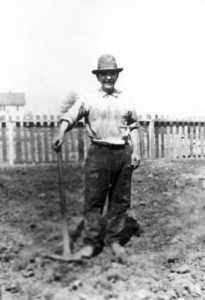 became renowned leaders in the Ottoman empire. Then the only original and truly free men of the highlands were the Shqipetare living in the hills of Italy. If you look into the names of your Del Calzo ancestors in Chieuti you will find the name Nicolo Castrioto from about 1740 who was the great, great, great grandfather of Eugenia Magnocavallo, Giuseppe DelCalzo’s wife. It was Giuseppe Del Calzo who brought his Shquipetare family to America in 1901, a journey started in Albania over 500 years ago to find a piece of land they could call their own, live in freedom, and worship as they pleased. In commemoration of our Shqiptarian and Italian heritage, the Del Calzo family crest* depicts the double headed eagle of the “Sons of the Eagles” and the falcon topped watchtower of the village of Chieuti.
became renowned leaders in the Ottoman empire. Then the only original and truly free men of the highlands were the Shqipetare living in the hills of Italy. If you look into the names of your Del Calzo ancestors in Chieuti you will find the name Nicolo Castrioto from about 1740 who was the great, great, great grandfather of Eugenia Magnocavallo, Giuseppe DelCalzo’s wife. It was Giuseppe Del Calzo who brought his Shquipetare family to America in 1901, a journey started in Albania over 500 years ago to find a piece of land they could call their own, live in freedom, and worship as they pleased. In commemoration of our Shqiptarian and Italian heritage, the Del Calzo family crest* depicts the double headed eagle of the “Sons of the Eagles” and the falcon topped watchtower of the village of Chieuti.
Just in case you’re wondering about the black prince, Vlad Dracula, people were eager to forget about him after he was killed in Bucharest in 1473. However in the small villages high in the Carpathian mountains of Transylvania, when the sun goes down the families still huddle around the fire place and they still whisper about Vlad, now known simply as Dracula, who centuries ago killed so many for his love of blood. Some believe that he still roams the hills at night in the form of a vampire bat searching for blood. While some scoff at this notion they still shudder when they lock their doors as the sun goes down at night in the Carpathian mountains, and pray that it will soon be morning. You probably know of Vlad as the Count Dracula now popular as the undying vampire in movies and books.
Skanderbeg died of exhaustion and fever in 1469 trying to rally allies to preserve Christianity in Europe. For six centuries the Albanians have not enjoyed the freedom they loved. But the Sons of the Eagle in Albania and Italy and now in countries around the world still gather and tell their children the legend of Skanderbeg and honor their brave white knight and hope that some day he will return. That he will come riding on the long beams of sunlight that rise above their jagged mountains and he will restore freedom, independence, and glory to his descendents who are the rightful rulers of his land.
Primianno Vito DelCalzo, Ph.D.
Hiram, Ohio
Primo Vito DelCalzo
Chieuti ancestors immigrated to: Cleveland, Ohio
Surnames: delCalzo, Napolano, Magnocavallo, Petrucci
Del Calzo Family Crest
The following is a description of a family crest devised to represent the Del Calzo Family based on its origins and travels.
The Shield, bordered in blue with a white cross on a red background, is taken from the coat of arms of the House of Savoy which was the ruling family of Italy during the time it was kingdom from 1848 until 1946. Our ancestors emigrated to the United States from the Kingdom of Italy not from the current Republic of Italy.
For our family crest we have added four additional devices to the four quadrants of the shield as follows.
The Upper Left Quadrant holds a black double headed eagle which goes back to George Castriota, an Albanian Christian who became a Turkish general in the 15th century under the name of Iskander Beg, or Skanderbeg. He later returned to the Christian faith and led the fight of the Albanians against the Turks in the 1440’s. He used the Byzantine two-headed eagle on his seals, hence its association with Albania. It is quite likely that our ancestors emigrated from Albania to Italy during the 1400s.
The Upper Right Quadrant holds the gonfalon of the commune of Chieuti. (All Italian towns have a gonfalon, a banner suspended from a crossbar, which is the official emblem of the town.) The village of Chieuti is an enclave of Albanian speaking Italians located in the Province of Foggia in the northern part of a region known as Apulia or Puglia. Our oldest known ancestors were from Chieuti.
The Lower Right Quadrant holds the national arms of Brazil. From 1892 to 1900 Giuseppe Del Calzo and his family lived in Brazil and worked on a coffee plantation. Giuseppe’s wife Eugenia gave birth to two daughters, Marietta and Lucia, while in Brazil.
The Lower Right Quadrant holds the seal of the state of Ohio. In 1901 the Giuseppe Del Calzo branch of the Del Calzo family emigrated to the United States and settled in Cleveland, Ohio. As the family grew, the majority of the following generations continued to live in Northeast Ohio, principally in the City of Cleveland and its suburbs.
The Helm (a heraldic term) which sits atop the shield is the helmet of Skanderbeg. The original helmet is preserved in Vienna. The helmet bears goat horns, and legend says that Skanderbeg chose goat horns because he was able to climb upon rocks like a goat to set up ambushes against the Turkish troops. His victories against the huge Turkish Army were due to his knowledge of the terrain of his native land, his use of guerilla tactics, and his political skills in uniting all the Albanian tribes.
All postcards and photographs on this page provided by Primo DelCalzo.
Arbëresh/Kastrioti links
Wikipedia – Kastrioti
Wikipedia – Arberesh
History of Albanians in Italy
